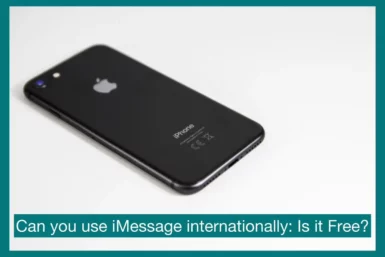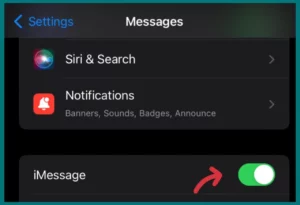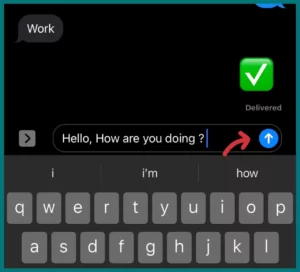Have you ever wondered if using iMessage internationally is free of cost?
Understanding how Apple’s iMessage service operates internationally can help you avoid unexpected charges in this increasingly connected world. Let’s explore this interesting topic.
Does iMessage Work Internationally?
Yes, Apple’s messaging service, iMessage, is accessible and usable everywhere as long as you have an internet connection.
There are no geographical limitations when sending and receiving iMessages to and from other Apple users. Like any other internet-based service, the quality of the service will mostly depend on your data or Wi-Fi connection.
Is It Free to Use iMessage Internationally?
Yes, it is free to use iMessage internationally. There are no direct fees associated with using iMessage internationally from Apple.
There are no international messaging costs with iMessage because it uses your data connection, whether it is Wi-Fi or mobile data.
Imessage over a Wi-Fi Connection
You can send and receive iMessages without concern for fees when you are connected to Wi-Fi. This effectively makes using iMessage on Wi-Fi free, whether you’re messaging someone nearby or halfway over the world.
Free Wi-Fi is frequently available in hotels, cafes, and public spaces, making it a great way to remain connected without paying more.
Using Cellular Data
Apple does not charge you for using iMessage over a cellular connection, but it does use your allocated data. Depending on the rules of your mobile carrier, data roaming fees might be charged if you travel internationally.
Before using iMessage (or any other internet service) on cellular data when traveling, reviewing the details of your data plan to prevent potentially expensive roaming fees is crucial.
Steps to Send iMessage Internationally
To make sure you can send and receive iMessages internationally follow the steps given bellow:
1. Ensure Device Compatibility
First and foremost, it’s essential to understand that iMessage is an Apple-specific service and can only be used with Apple products like iPhones, iPads, and Macs.
So, the person receiving your message must be using an Apple device. You can begin sending messages abroad if the sender and recipient satisfy these conditions.
2. Setting Up iMessage
You must configure the iMessage service on your Apple device before you send an iMessage. Go to the Settings app, select “Messages,” then turn the iMessage switch on.
For iMessage to activate, you might have to wait a little while. During this process, you must have access to the internet, whether it be by Wi-Fi or cellular data.
3. Process for International Messaging
International iMessage sending is the same as domestic iMessage sending. All you have to do is open the Messages app, start a new message, and enter the recipient’s contact information.
The contact information of that individual will be highlighted in blue if they have iMessage activated as well. Write your message, and then click “Send.”
4. Wi-Fi and Cellular Data Usage
As was previously said, iMessage utili-6t 9pzes your data connection. It costs nothing to send an iMessage when using Wi-Fi.
iMessage will use a little portion of your data allowance if you’re using cellular data. Always remember the potential data fees when traveling internationally when you’re not connected to Wi-Fi.
5. Fix Minor iMessage Issues
You could occasionally run into problems when attempting to send iMessages internationally. This can happen due to some minor glitches with your iMessage app or iPhone. Minor software bugs can be easily fixed by restarting your device.
Reasons Why You May Not Be Able to Use iMessage Internationally
There are a few possible reasons why you might be unable to use iMessage internationally, the most of them can be resolved with a little bit of planning and troubleshooting.
Device Compatibility Issues
Device compatibility may be a factor in your inability to use iMessage internationally. You can only use iMessage on Apple products, such as iPhones, iPads, or Macs, as it is an Apple service.
Further, the person who receives your messages must also be using an Apple device. You won’t be able to use iMessage if either the sender or the recipient is using an Android smartphone or another device that iMessage doesn’t support.
Lack of Internet Connectivity
iMessage cannot function without an active internet connection, whether it is Wi-Fi or cellular data.
You won’t be able to send or receive iMessages if your location has poor or no internet access. This is frequently the case when traveling internationally, especially in rural or places without data service.
Roaming Restrictions
When you are traveling internationally, some cellular service providers may restrict or limit your data usage.
These limitations may impact your ability to use data-dependent services like iMessage. Before leaving on a trip, it’s usually a good idea to ask your provider about their roaming and international data plans.
Incorrect iMessage Settings
You can experience issues sending or receiving iMessages if your iMessage settings aren’t set up properly. For example, you might not be logged into your Apple ID or have iMessage turned off in your settings. If you’re having issues with iMessage, always check your settings again.
Blocked Contacts
Apple gives customers the option to block certain contacts, stopping them from making calls or sending iMessages. You won’t be able to send iMessages to contacts who have blocked your number and vice versa.
Software Issues
Occasionally, you could run into bugs or software issues that make iMessage malfunction. In these circumstances, rebooting your device or updating its software will typically fix the problem.
Conclusion
iMessage is a practical and efficient communication tool for Apple consumers, particularly while traveling internationally. Without any additional charges from Apple, it functions globally over Wi-Fi or cellular data.
However, depending on your mobile plan, data fees can be charged. Even though software problems, internet connectivity, roaming limitations, and device compatibility problems may exist, most issues can be resolved with careful preparation and troubleshooting.
To make the most of iMessage’s features while traveling, it’s essential to be aware of your data plan and ensure you have access to Wi-Fi whenever possible.



